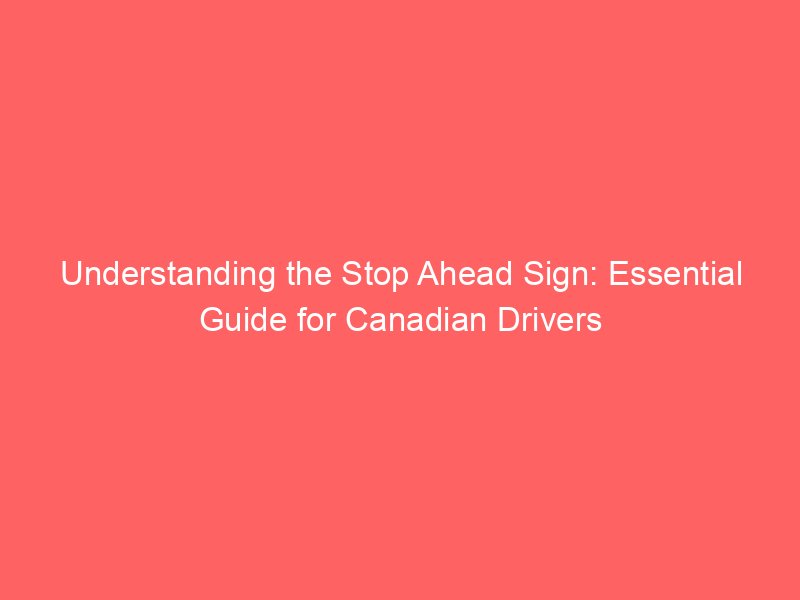The stop ahead sign is a crucial part of Canadian road safety. It warns drivers that a stop sign is coming up soon, giving them time to slow down and prepare to stop. This simple warning can prevent accidents and keep traffic flowing smoothly.
What Is a Stop Ahead Sign?
The stop ahead sign alerts drivers that a stop sign is approaching. It’s a yellow diamond-shaped sign with a black stop symbol and an arrow pointing ahead. This advance notice helps drivers avoid sudden stops, especially in areas where the stop sign might be hard to see.
The sign is often placed several hundred meters before the actual stop sign. This distance varies depending on the road type and speed limit. The goal is to give drivers enough time to react safely.
Why Is the Stop Ahead Sign Important?
Stop signs control traffic at intersections, but sometimes drivers might not see them in time. The stop ahead sign acts as an early warning. It reduces the risk of rear-end collisions and intersection crashes.
In Canada, where weather conditions like fog, snow, or heavy rain can reduce visibility, these signs are even more valuable. They help drivers anticipate stops when the road or weather conditions make it hard to spot the stop sign itself.
Design and Specifications in Canada
The stop ahead sign in Canada follows strict standards set by provincial transportation authorities and the Transportation Association of Canada (TAC). The sign’s background is fluorescent yellow for high visibility, with black and red symbols.
Materials used are durable aluminum sheets, often coated with reflective sheeting. This reflective surface ensures the sign is visible both day and night. For example, 3M™ Diamond Grade Cubed (DG³) fluorescent yellow sheeting is common, offering up to 10 times the brightness of older materials.
Sizes typically range from 75 cm by 75 cm (30 inches by 30 inches) to 120 cm by 120 cm (48 inches by 48 inches). These sizes ensure visibility from a distance appropriate to the road’s speed limit.
Where Are Stop Ahead Signs Used?
You’ll find stop ahead signs mainly on roads where the stop sign is not easily visible. This includes:
- Roads with sharp curves before the stop sign
- Areas with frequent fog or heavy snowfall
- Rural roads with limited lighting
- High-speed roads where sudden stops are dangerous
They’re also used near railway crossings or places where traffic regulations change suddenly.
Legal and Safety Compliance
Canadian stop ahead signs comply with the Manual of Uniform Traffic Control Devices for Canada (MUTCDC). This manual guides the design, placement, and maintenance of traffic signs nationwide.
Signs must meet ASTM standards for materials and reflectivity. They also require mounting holes for secure installation. Provinces like Alberta have specific product codes and standards to ensure consistency.
How Drivers Should Respond to Stop Ahead Signs
When you see a stop ahead sign, it’s time to reduce your speed and prepare to stop. Don’t wait until you see the stop sign itself. Slowing down early helps maintain control and gives you time to check for other vehicles or pedestrians.
Failing to heed this warning can lead to dangerous situations, especially if the stop sign is around a blind corner or hidden by trees.
Differences in Stop Signs Across Canada
While the stop ahead sign is consistent, actual stop signs can vary. In Quebec, for example, stop signs often say Arrêt instead of Stop. Some areas have bilingual signs, displaying both English and French. Indigenous languages may also appear on signs in First Nations territories.
Despite these variations, the stop ahead sign remains a universal symbol, using clear graphics rather than text to communicate its message.
Anecdote: A Close Call on a Foggy Road
Imagine driving on a foggy Alberta highway. Visibility drops to just a few meters. Suddenly, you see a stop ahead sign. You slow down, knowing a stop sign is coming. Without that warning, you might have missed the stop sign completely, risking a crash. That sign gave you the heads-up you needed to stay safe.
Conclusion
The stop ahead sign is a simple but vital tool for Canadian road safety. It helps drivers prepare for stops, reducing accidents and improving traffic flow. Its design, placement, and materials meet strict standards to ensure visibility in all conditions. Paying attention to this sign can make the difference between a safe stop and a dangerous situation.
